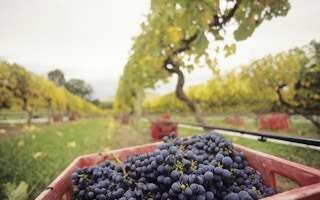Slip, slop, slap. It was a cartoon seagull wearing shorts, t-shirt and a hat that famously urged sun-loving Australians in the 1980s to protect themselves from damaging ultraviolet rays.
While sunblock has shielded generations from harm, it is also being used to safeguard the health and vitality of Australian grapes as the nation reflects on another scorching year when temperature records continued to tumble.
At Tyrrell’s vineyard in the Hunter Valley, 165km north of Sydney, the midday sun beats down on some of Australia’s oldest vines. They date back to the late 1800s, and have thrived in tough conditions.
The quality of the vintage depends not only on the sun and the soil, but the temperature. Very hot weather can inflict serious damage, and too much heat can cause the berries to shrivel or suffer sunburn.
“You put sunscreen on your kids when they go out in the sun, so we put it on our grapevines. That just goes on like a normal spray,” says Bruce Tyrrell, the chief executive of Tyrrell’s Wines.
“Your vineyard gets this funny white-blue colour, and you look on the berries and there is a little coating on them. It is just like putting sunscreen on and it gives it some protection.”
It’s not only science that is helping to protect the crop, but also sound husbandry in a region where temperatures can exceed 45C (113F).
“It is a matter of having your vineyard laid out to handle your conditions,” Mr Tyrrell tells the BBC.
“
They are thinking about how can we insure for extreme events like bushfires that are precipitated by heatwaves, so they have to model for an increasingly unpredictable climate
Prof Christopher Wright, University of Sydney Business School
“We plant north-south rows, so that you don’t have the western sun directly on the fruit.”
Heatproofing businesses
Scientists have predicted that climate change will make heatwaves in Australia more frequent and severe - and when the mercury rockets, so do the economic costs.
When Melbourne sweltered through a four-day hot spell in January 2014, it is estimated that firms in the city lost about 10m Australian dollars ($8m; £5m) in revenue each day.
A subsequent survey found around 60 per cent of businesses expect that more regular heatwaves over the next 20 years would hit their profits.
Prof Christopher Wright from the University of Sydney Business School explains that many industries would have to heatproof their operations, including agriculture, retail and insurance companies.
“They are thinking about how can we insure for extreme events like bushfires that are precipitated by heatwaves, so they have to model for an increasingly unpredictable climate.
“Large shopping centres are looking at dramatic increases in electricity costs as they try to increase air conditioning,” he says.
“Heatwaves are becoming longer, and they are becoming more severe, and that becomes hard to manage depending in which business sector you are in.
“So my own take is that a lot of businesses are probably fairly unprepared for what is coming,” he adds.
Health warning
Heatwaves cause more deaths each year in Australia than any other natural disaster, and they pose particular risks to the bedrock of the economy: the workforce.
In November, the Electrical Trades Union (ETU) issued a health warning to staff working outdoors across the state of New South Wales as extreme heat took hold.
When temperatures exceed 38C (100F), work is automatically halted because of the risk of heat rashes, cramps and exhaustion.
“Our union has produced a detailed policy for working in heat,” says ETU secretary Steve Butler. “Extreme heat can cause a range of health problems, from the uncomfortable to the potentially deadly.”
Two years ago, Sydney experienced its hottest day on record when temperatures passed 45C. It was a punishing time for those not able to seek air-conditioned relief, as a crushing heat smothered the nation’s biggest city.
Many shoppers stayed at home, but it was workers who had to bear the brunt of the conditions.
“It made people feel lethargic,” says Russell Zimmerman, the head of the Australian Retailers Association.
“There were trials getting people to and from work. Obviously you’ll have people who go by public transport. Invariably on a really hot day you get some kind of problem with public transport, be it rails buckling or vehicles breaking down.”
Shaped by climate
Yet, this is a land of extremes. And while there is disagreement about man’s influence on the climate, there is a shared belief that Australia has thrived in the face of unrelenting environmental challenges, from drought to floods, to bushfires and a burning sun.
A nation’s prosperity could now depend on how it adapts to a warmer future.
“The tyranny of extreme climate has shaped us,” says Tim Harcourt from the University of New South Wales Business School.
“If Australia had a beautiful, temperate climate all-round, we’d be a very different people.
“We have faced great climate challenges through our history, and that is partly the way we shape our character and we shape our approach to the economy.”

















